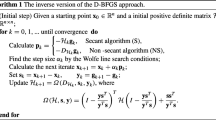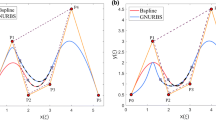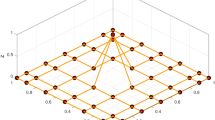Abstract
Fast and accurate fitting of non-uniform rational B-spline (NURBS) curves and surfaces through large sets of measured data is an important problem in applications such as reverse engineering and geometric modelling. This paper presents a method for realising significant improvements in the computational efficiency of this task. The basic idea is that the sparsity structures of the relevant matrices that are specific to the problem of NURBS fitting can be precisely defined and that full exploitation of these structures leads to significant savings in both computational and storage requirements. These savings allow for a large number of control points to be used in order to define the surface and consequently to improve the accuracy of shape representation. The achieved computational complexity is linear in both the number of measured points and the number of control points while the storage requirements of the algorithm are linear with the number of control points only. The complexity analysis, as well as the analysis of actual running times is presented. The results demonstrate that, using this approach, highly complex shapes may be modelled accurately with a single NURBS surface.
Similar content being viewed by others
References
Dan J, Lancheng W (2006) An algorithm of NURBS surface fitting for reverse engineering. Int J Adv Manuf Technol 31:92–97
Ma W, Kruth JP (1998) NURBS curve and surface fitting for reverse engineering. Int J Adv Manuf Technol 14:918–927
Gao J, Chen X, Yilmaz O, Gindy N (2008) An integrated adaptive repair solution for complex aerospace components through geometry reconstruction. Int J Adv Manuf Technol 36:1170–1179
Varady T, Martin RR, Cox J (1997) Reverse engineering of geometric models, an introduction. Comput Aided Des 29(4):255–268
Weiss V, Andor L, Renner G, Varady T (2002) Advanced surface fitting techniques. Comput Aided Geom Des 19:19–42
Armstrong CG, Monaghan DJ, Price MA, Ou H, Lamont J (2002) Integrating CAE Concepts with CAD Geometry. In: Topping B, Bittnar Z (eds) Engineering computational technology. Civil-Comp Press, Edinburgh, pp 75–104
Dietz U (1996) B-Spline approximation with energy constraints. In: Hoschek J, Kaklis P (eds) Advanced course on fairshape. Teubner, Stuttgart, pp 229–240
Che X, Liang X, Li Q (2005) G1 continuity conditions of adjacent NURBS surfaces. Comput Aided Geome Des 22:285–298
Koch KR (2009) Identity of simultaneous estimates of control points and of their estimates by the lofting method for NURBS surface fitting. Int J Adv Manuf Technol 44:1175–1180
Pereyra V, Scherer G (2002) Least squares scattered data fitting by truncated SVDs. Appl Numer Math 40:73–86
Brujic D, Ristic M, Ainsworth I (2002) Measurement-based Modification of NURBS surfaces. Comput Aided Des 34(3):173–183
Piegl L, Tiller W (1997) The NURBS book, 2nd edn. Springer, Berlin
Bjorck A (1996) Numerical methods for least squares problems. Society for Industrial and Applied Mathematics, Philadelphia
Golub GH, Van Loan CF (1996) Matrix Computations, 3rd edn. Johns Hopkins, Baltimore, MD
Press WH, Teukolsky SA, Vetterling SW, Flannery BP (1993) Numerical recipes in C: the art of scientific computing, 2nd edn. Cambridge University Press, Cambridge, UK
Farin G (2002) Curves and Surfaces for CAGD A Practical Guide, 5th edn. Morgan-Kaufmann, San Francisco, CA
Brujic D (2002) A Framework for CAD based Shape Metrology. Dissertation, Imperial College
Ma W, Kruth JP (1995) Parameterization of randomly measured points for least squares fitting of B-spline curves and surfaces. Comput Aided Des 27:663–675
Piegl LA, Tiller W (2001) Parameterization for surface fitting in reverse engineering. Comput Aided Des 33:593–603
Ma YL, Hewitt WT (2003) Point inversion and projection for NURBS curve and surface: control polygon approach. Comput Aided Geom Des 20:79–99
Dierckx P (1993) Curve and surface fitting with splines. Clarendon, Oxford
George A, Liu J (1981) Computer solution of large sparse positive definite systems. Prentice-Hall, Englewood Cliffs, NJ
Varga RS (1962) Matrix iterative Analysis. Prentice-Hall, Englewood Cliffs, NJ
Young DM (1971) Iterative solution of large linear systems. Academic, New York
Yin Z (2004) Reverse engineering of a NURBS surface from digitized points subject to boundary conditions. Comput Graph 28(2):207–212
Author information
Authors and Affiliations
Corresponding author
Rights and permissions
About this article
Cite this article
Brujic, D., Ainsworth, I. & Ristic, M. Fast and accurate NURBS fitting for reverse engineering. Int J Adv Manuf Technol 54, 691–700 (2011). https://doi.org/10.1007/s00170-010-2947-1
Received:
Accepted:
Published:
Issue Date:
DOI: https://doi.org/10.1007/s00170-010-2947-1




